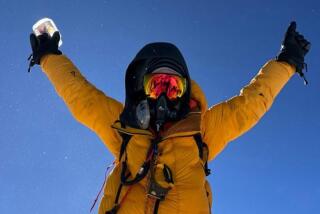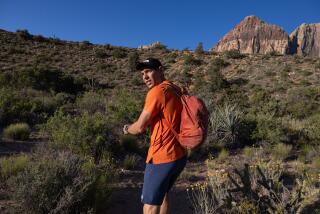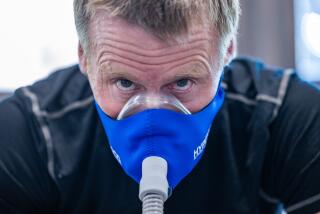Paul Petzoldt; Pioneering Mountaineer, School Founder
- Share via
By his own definition, Paul Petzoldt was a contradiction in terms.
“There are old climbers, and there are bold climbers,” he said, “but there are no old, bold climbers.”
Petzoldt, however, was an old, bold climber. In 1994, when he was 86 and suffering from glaucoma, he tackled Wyoming’s formidable Grand Teton to commemorate the 70th anniversary of his first trek to the top of that 13,766-foot peak.
He made it to 11,000 feet and decided that was enough for a blind octogenarian, even if he was Paul Petzoldt, the legendary climber considered king of winter mountaineers.
Petzoldt, who had a ridge of the peak he so loved to climb named after him, died Wednesday of prostate cancer at a nursing home in Topsham, Maine. He was 91.
He was a celebrated alpinist who pioneered a number of mountaineering techniques. As founder of the National Outdoor Leadership School, he also was called the father of wilderness education.
Former U.S. Sen. Alan Simpson of Wyoming, who worked with Petzoldt on environmental legislation, called the climber a “warm, wise, witty bear of a man” who “had the guts and courage of a mountain lion.”
Born and raised on an Idaho ranch near Snake River Canyon, Petzoldt loved the outdoors from an early age. He led trips into the Sawtooth range when he was only 12.
In 1924, when he was 16, he pulled on cowboy boots, overalls and a blue shirt and bundled a few supplies in a blanket to make his first assault on the Grand Teton peak, which towers above Jackson Hole. During the climb he recovered the body of Theodore Teepe, the first person to die while attempting to ascend Grand Teton. Petzoldt nearly froze to death, but weathered a howling blizzard to reach the summit with his friend Ralph Herron.
By the time they returned to the bottom, Petzoldt’s boots had disintegrated and his feet were bleeding.
“This experience,” he later wrote, “set the direction of my life. I knew that if I wanted to live to be an old mountaineer, I could not take such chances and be so uninformed about dangerous activities.”
He launched the first guide service in Grand Teton National Park in the early 1930s and spent the next three decades leading people into the Teton range. He also built an international reputation as a climber.
In 1934 Petzoldt made alpinist history with a “double traverse” of the Matterhorn, ascending on the Swiss side, crossing the hazardous Italian ridge, then descending the Swiss side, all in 14 hours.
In 1936, he and two other mountaineers made the first winter ascent of Grand Teton. And Petzoldt climbed K2--the Himalayan peak considered the most challenging in the world--as part of the first American expedition in 1938. He set a record for the longest continuous climb without artificial oxygen at an altitude of more than 20,000 feet.
While training ski troops in Colorado during World War II, Petzoldt began to experiment with wilderness survival techniques, gradually developing a philosophy and a system.
Among the contributions he made to mountaineering were the first voice signal system for climbers and the “sliding middleman” method used in snow climbing.
In 1963, he helped establish the first American Outward Bound program, in Colorado, where he was chief instructor, and tried to teach his system of wilderness living to others. In 1965 he started a school.
The National Outdoor Leadership School opened in Lander, Wyo., with 100 students and three teachers. Using the nearby Wind River range, the school taught people how to live responsibly in the wilderness and conserve nature.
One of the institution’s trademark objectives was something called “minimum impact camping,” which taught people how to enjoy camping without damaging the wilderness. Over the past 30 years, the school has trained 50,000 people in outdoor safety and ethics around the world.
For years, Petzoldt made an annual winter climb of Grand Teton, which he considered a more formidable mountain than Everest in that season. The last 60 feet are particularly perilous, involving steep acrobatic climbing on icy rocks.
No one knows how many times Petzoldt climbed Grand Teton. And his zest for the challenging peak never diminished.
He made it to the top in 1984 on the 60th anniversary of his first ascent. He was 76.
A decade later, he returned for what would be his last ascent. Aided by four former students and trained instructors, Petzoldt took two or three steps with each measured breath, practicing the rhythmic breathing method he developed in 1938 when he took on K2.
He stopped about 2,000 feet short of the summit but did not seem disappointed. He had enjoyed the sunshine, soft breezes and magnificent vistas.
“I never could see the sense of going to the top of the goddamn mountain just because it was there. If that’s all it means,” he said in an interview many years earlier, “you might as well stay at the bottom in the bar.”
Petzoldt is survived by his wife, Virginia. A memorial service will be held Oct. 16 at 11 a.m. at St. Anne’s Church in Windham, Maine. Donations may be sent to the Paul Petzoldt Legacy Scholarship at the National Outdoor Leadership School, 288 Main St., Lander, WY 82520.
More to Read
Sign up for Essential California
The most important California stories and recommendations in your inbox every morning.
You may occasionally receive promotional content from the Los Angeles Times.











